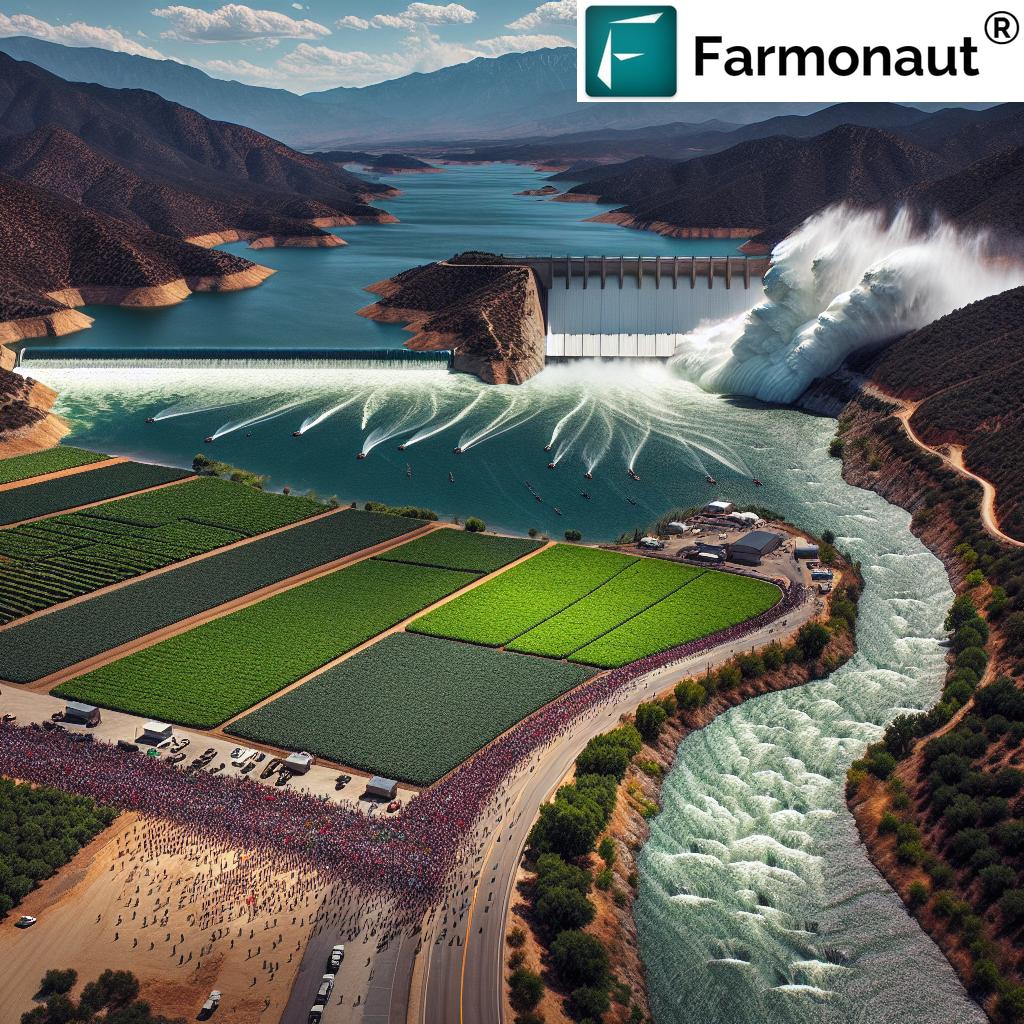California Water Crisis: Controversial Lake Kaweah Release Sparks Flooding Concerns in Tulare County
“Lake Kaweah’s controversial water release affects over 400,000 acres of farmland in California’s Central Valley.”
In the heart of California’s agricultural heartland, a storm is brewing – not of rain, but of controversy. The recent decision by the U.S. Army Corps of Engineers to release water from Lake Kaweah and Success Lake in Tulare County has ignited a firestorm of debate, pitting federal actions against local water management needs. As we delve into this complex issue, we’ll explore the far-reaching implications for California’s water management, agricultural lands, and the delicate balance of our ecosystem.
The Controversial Water Release: A Timeline of Events
On January 30, 2023, the U.S. Army Corps of Engineers made a decision that would send ripples through California’s water management community. The controversial release of water from Lake Kaweah and Success Lake in Tulare County was ostensibly aimed at assisting wildfire suppression efforts in Los Angeles County. However, this action quickly drew criticism from various quarters, including Senator Alex Padilla, who raised alarm bells about potential flooding on agricultural lands.
The timing of this release coincided with an Executive Order issued by then-President Trump on January 24, which claimed that California’s water policy was responsible for the wildfires. This order aimed to maximize water deliveries to California, setting the stage for heightened tensions over water management and regulatory practices.

The Ripple Effect: Concerns and Criticisms
The aftermath of the water release saw a surge of concerns from various stakeholders. Senator Padilla accused the Corps of recklessly endangering lives due to insufficient coordination and notification regarding the unscheduled water releases. Local water managers echoed these sentiments, emphasizing the legal complexities surrounding California water rights and the impracticality of using river water from Tulare County for wildfire suppression efforts in Southern California.
As a result of the emergency releases, river flows sharply increased, causing local irrigation districts to voice concerns over the potential for flooding and damage. This situation highlights the delicate balance that must be struck in California’s water management, where every drop of water has a designated owner and purpose.
The Environmental Impact: A Closer Look
While the immediate concerns focus on flooding and agricultural impacts, we must not overlook the potential environmental consequences of these water releases. California’s fish populations, particularly the Central Valley salmon and Delta fish, are already under considerable threat due to ongoing water management practices.
“The Sacramento-San Joaquin Delta, impacted by these water decisions, supports over 750 plant and animal species.”
Recent years have seen significant declines in critical fish species, leading to shutdowns of salmon fishing due to their dwindling populations. Critics warn that hasty water management decisions could further endanger these species already facing existential threats.
The Role of Technology in Water Management
In the face of these complex challenges, technology plays an increasingly crucial role in water management and agricultural practices. Companies like Farmonaut are at the forefront of this technological revolution, offering advanced, satellite-based farm management solutions that can help farmers and water managers make more informed decisions.
Through its API and mobile applications (
 ), Farmonaut provides real-time crop health monitoring, AI-based advisory systems, and resource management tools. These technologies can be instrumental in optimizing water usage and mitigating risks associated with water management decisions.
), Farmonaut provides real-time crop health monitoring, AI-based advisory systems, and resource management tools. These technologies can be instrumental in optimizing water usage and mitigating risks associated with water management decisions.
Comparative Analysis: Water Release Impacts
| Impact Category | Tulare County Effects | Los Angeles County Effects | Environmental Consequences |
|---|---|---|---|
| Flooding Risk | High risk to 400,000+ acres of farmland | Minimal flooding risk | Potential erosion and habitat disruption |
| Agricultural Land | Crop damage and potential yield loss | No direct agricultural impact | Soil nutrient depletion from excess water |
| Irrigation Needs | Reduced water availability for summer irrigation | Increased water availability for urban use | Altered water cycles affecting native flora |
| Endangered Species | Potential disruption of local ecosystems | Minimal impact on local species | Significant risk to Delta fish and salmon populations |
The Political Dimension: Federal vs. State Water Management
The controversy surrounding the Lake Kaweah water release underscores the ongoing tension between federal and state water management policies. The Trump administration’s Executive Order aimed at maximizing water deliveries to California clashed with state-level concerns about environmental protection and sustainable water use.
This conflict highlights the need for better coordination between federal agencies, state authorities, and local water managers. It also raises questions about the effectiveness of top-down water management decisions in addressing the complex and varied needs of different regions within California.
The Future of California’s Water Management
As we look to the future, it’s clear that California’s water management challenges will require innovative solutions and collaborative approaches. The integration of advanced technologies, such as those offered by Farmonaut, can play a crucial role in optimizing water use and mitigating risks.
Some key areas for future focus include:
- Improved coordination between federal, state, and local water management entities
- Investment in water-efficient agricultural practices and technologies
- Enhanced monitoring and early warning systems for flood risks
- Comprehensive strategies for balancing human water needs with environmental conservation
The Role of Precision Agriculture in Water Conservation
In the face of California’s water crisis, precision agriculture emerges as a beacon of hope. Technologies like those developed by Farmonaut offer farmers the tools to make data-driven decisions about water usage, crop management, and resource allocation.
By leveraging satellite imagery and AI-powered analytics, farmers can:
- Monitor crop health in real-time
- Optimize irrigation schedules
- Detect early signs of water stress or disease
- Reduce water waste and improve overall farm efficiency
These advancements not only benefit individual farmers but also contribute to the broader goal of sustainable water management across the state.
The Economic Impact of Water Management Decisions
The controversial water releases from Lake Kaweah and Success Lake highlight the significant economic implications of water management decisions. The potential flooding of agricultural lands in Tulare County could lead to substantial crop losses and economic hardship for farmers and local communities.
On the other hand, the intended use of this water for wildfire suppression in Los Angeles County underscores the complex trade-offs between different economic priorities. Balancing the needs of agriculture, urban areas, and environmental conservation presents an ongoing challenge for policymakers and water managers.
Innovative Solutions for a Sustainable Future
As California grapples with its water crisis, innovative solutions are emerging that could help address these complex challenges. Some promising approaches include:
- Water recycling and reuse: Implementing advanced water treatment technologies to recycle and reuse water for agricultural and urban purposes.
- Smart water grids: Developing interconnected water distribution systems that use real-time data to optimize water allocation and reduce waste.
- Drought-resistant crops: Investing in research and development of crop varieties that can thrive with less water.
- Artificial intelligence in water management: Utilizing AI and machine learning algorithms to predict water needs, detect leaks, and improve overall system efficiency.
Companies like Farmonaut are at the forefront of these innovations, providing farmers and water managers with the tools they need to make informed decisions and optimize resource use.

The Importance of Public Awareness and Education
As we navigate the complexities of California’s water crisis, public awareness and education play a crucial role. Informed citizens can better understand the trade-offs involved in water management decisions and participate more effectively in the policy-making process.
Key areas for public education include:
- Understanding the water cycle and California’s unique water challenges
- The impact of individual water usage on the broader ecosystem
- The role of technology in modern water management and agriculture
- The importance of balancing human needs with environmental conservation
By fostering a more informed public, we can work towards more sustainable and equitable water management practices that benefit all Californians.
The Path Forward: Collaborative Solutions for California’s Water Future
As we reflect on the controversy surrounding the Lake Kaweah water release and its broader implications for California’s water management, it’s clear that the path forward requires collaboration, innovation, and a commitment to sustainability. We must work together to find solutions that balance the needs of agriculture, urban areas, and the environment.
Key steps for moving forward include:
- Fostering better communication and coordination between federal, state, and local water management entities
- Investing in research and development of water-efficient technologies and practices
- Implementing comprehensive water management strategies that consider long-term sustainability
- Embracing technological solutions, such as those offered by Farmonaut, to optimize water use and improve agricultural efficiency
- Engaging the public in water conservation efforts and policy discussions
By taking these steps, we can work towards a more sustainable and resilient water future for California.
Earn With Farmonaut: Join Our Affiliate Program
Earn 20% recurring commission with Farmonaut’s affiliate program by sharing your promo code and helping farmers save 10%. Onboard 10 Elite farmers monthly to earn a minimum of $148,000 annually—start now and grow your income!
For more information about our affiliate program, visit Farmonaut’s Affiliate Program.
Farmonaut Subscriptions: Empowering Farmers with Cutting-Edge Technology
Frequently Asked Questions
- What was the main reason for the controversial water release from Lake Kaweah?
The U.S. Army Corps of Engineers released water to assist in combating wildfires in Los Angeles County, despite concerns about potential flooding in Tulare County. - How does this water release impact California’s agricultural sector?
The release poses risks of flooding to over 400,000 acres of farmland in the Central Valley, potentially leading to crop damage and reduced water availability for summer irrigation. - What role does technology play in addressing California’s water management challenges?
Companies like Farmonaut offer advanced satellite-based farm management solutions that help optimize water usage, monitor crop health, and improve overall agricultural efficiency. - How are endangered species affected by these water management decisions?
The water releases can potentially disrupt local ecosystems and pose significant risks to Delta fish and salmon populations, which are already facing declining numbers. - What steps can be taken to improve California’s water management in the future?
Key steps include better coordination between federal, state, and local entities, investing in water-efficient technologies, implementing comprehensive management strategies, and engaging the public in conservation efforts.
In conclusion, the controversy surrounding the Lake Kaweah water release serves as a stark reminder of the complex challenges facing California’s water management. As we navigate these issues, it’s clear that innovative solutions, collaborative approaches, and public engagement will be crucial in ensuring a sustainable water future for the Golden State. By leveraging advanced technologies and fostering a deeper understanding of our water resources, we can work towards a more resilient and equitable water management system that benefits all Californians.





